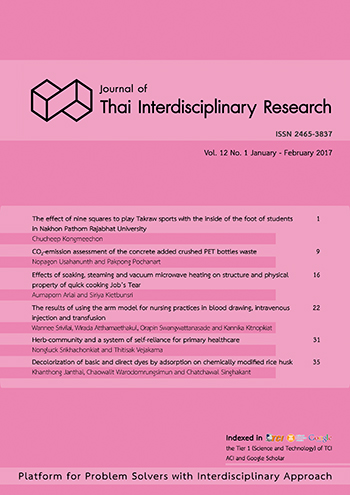Decolorization of basic and direct dyes by adsorption on chemically modified rice husk
Main Article Content
Abstract
Article Details
References
Tan IAW, Ahmad AL, Hameed BH. Adsorption of basic dye on high-surface-area activated carbon prepared from coconut husk: equilibrium, kinetic and thermodynamic studies. J Hazard Mater. 2008; 154: 337-46.
Sachdeva S, Kumar A. Preparation of nanoporous composite carbon membrane for separation of rhodamine B dye. J Membr Sci. 2009; 329: 2-10.
Crini G. Non-conventional low-cost adsorbents for dye removal: A review. Bioresour Technol. 2006; 97: 1061-85.
Hayelom Dargo Beyene. The potential of dyes removal from textile wastewater by using different treatment technology, a Review. International Journal of Environmental Monitoring and Analysis. 2014; 2(6): 347-53.
Gupta VK, Suhas. Application of low-cost adsorbents for dye removal - A review. J Environ Manage. 2009; 90: 2313-42.
Nigam P, Armour G, Banat IM, Singh D, Marchant R. Physical removal of textile dyes from effluents and solid-state fermentation of dye-adsorbed agricultural residues. Bioresour Technol. 2000; 72: 219-26.
Kannan N, Sundaram MM. Kinetics and mechanism of removal of methylene blue by adsorption on various carbons - a comparative study. Dyes Pigm. 2001; 51: 25- 40.
Raghuvanshi SP, Sigh R, Kaushik CP. Kinetics study of methylene blue dye biosorption on baggase. Appl Eco Environ Res. 2004; 2(2): 35- 43.
Sharma P, Kaur R, Baskar C, Chung WJ. Removal of methylene blue from aqueous waste using rice husk and rice husk ash. Desalination. 2010; 259: 249 -57.
Sungpet A. Removal of dyes from Rinsing Effluent by Chemically Modified Rice Husks. [thesis]. Bangkok, Thailand: King Mongkut's University of Technology Thonburi; 2011.
Suttanan R, Piyamongkala K. Kinetic and Thermodynamic Adsorption of Methylene Blue by Modified Rice Husk. The Journal of KMUTNB. 2011; 21(2): 337-48.
Chowdhury S, Mishra R, Saha PD. Adsorption thermodynamics, kinetics and isosteric heat of adsorption of malachite green onto chemically modified rice husk. Desalination. 2011; 265: 159 -68.
Bulut Y, Gozubenli N, Aydın H. Equilibrium and kinetics studies for adsorption of direct blue 71 from aqueous solution by wheat shells. J Hazard Mater. 2007; 144:300-6.
Mavioglu Ayan E, Secim P, Karakaya S, Yanik J. Oreganum Stalks as a New Biosorbent to Remove Textile Dyes from Aqueous Solutions. Clean - Soil, Air, Water. 2012; 40(8): 856–63.
Hameed BH, Mahmoud DK, Ahmad AL. Equilibrium modeling and kinetic studies on the adsorption of basic dye by a low-cost adsorbent: Coconut (Cocosnucifera) bunch waste. J Hazard Mater. 2008; 158: 65-72.
Safa Y, Bhatti HN. Kinetic and thermodynamic modeling for the removal of Direct Red-31 and Direct Orange-26 dyes from aqueous solutions by rice husk. Desalination. 2011; 272: 313–22.
Deniz F, Karaman S. Removal of Basic Red 46 dye from aqueous solution by pine tree leaves. Chem Eng J. 2011; 170: 67-74.
Consolin Filhoa N, Venancio EC, Barriquello MF, Hechenleitner AAW, Pineda EAG. Methylene blue adsorption onto modified lignin from sugar cane bagasse. Ecletica Quimica. 2007; 32(4): 63-70.
Doulati Ardejani F, Badii Kh, Limaee NY, Shafaei SZ, Mirhabibi AR. Adsorption of Direct Red 80 dye from aqueous solution onto almond shells: Effect of pH, initial concentration and shell type. J Hazard Mater. 2008; 151: 730-7.
Khattria SD, Singh MK. Removal of malachite green from dye wastewater using neem sawdust by adsorption. J Hazard Mater. 2009; 167: 1089-94.
Kavitha D, Namasivayam C. Experimental and kinetic studies on methylene blue adsorption by coir pith carbon. Bioresour Technol. 2007; 98: 14-21.


